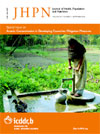
|
The Journal of Health, Population and Nutrition
icddr,b
ISSN: 1606-0997
EISSN: 1606-0997
Vol. 37, No. 1, 2018, pp. 1
|
 Bioline Code: hn18014
Bioline Code: hn18014
Full paper language: English
Document type: Research Article
Document available free of charge
|
|
|
The Journal of Health, Population and Nutrition, Vol. 37, No. 1, 2018, pp. 1
| en |
Intensity of contact with frontline workers and its influence on maternal and newborn health behaviors: cross-sectional survey in rural Uttar Pradesh, India
Lyngdoh, Tanica; Neogi, Sutapa B.; Ahmad, Danish; Soundararajan, Srinivasan & Mavalankar, Dileep
Abstract
Background: India is committed to improving maternal and newborn health in order to achieve the targets for
India’s Millennium Development Goal 4. Considering their role as a link between community and health systems,
frontline workers (FLWs) can be effectively utilized in strengthening maternal and newborn care. In this paper, we
set out to examine the effect of intensity of contact with FLWs on key maternal and newborn health behaviors and
to determine if this association varies by status of Self Help Group (SHG) membership.
Methods: This population-based cross-sectional study included 2208 currently married women aged 15–49 years
who had delivered a baby during the last 15 months prior to the survey and selected through a multi-stage cluster
sampling from rural villages and urban wards. The outcome of interest included variables related to key knowledge
and practice of healthy behavior in relation to maternal and newborn health and exposure variable considered was
intensity of contact with FLWs.
Results: Of the women interviewed, 1729 (78%) belonged to SHG household. For knowledge on the need for at
least 3 antenatal care (ANC) check-ups, two tetanus toxoid (TT) injections and consumption of 100 or more ironfolic
acid (IFA) tablets, proportion of those who were aware of these practices increased with increasing number of
contacts with FLWs (P value < 0.001). Practice for TT injections showed an increasing trend with increasing number
of contacts with FLW. An increase in the odds of delivering in an institution was observed in those who had higher
number of contacts as compared to those with no contacts (P value < 0.001). With regard to newborn healthy behavior
practice, breastfeeding within 1 h of delivery showed significant association and the odds of this practice improved in
those who had ≥ 3 contacts with FLW as compared to those had no contacts. Except for consumption of 100 or more
IFA tablets, there was no interaction of these associations by SHG status.
Conclusion: There was an overall low prevalence of both knowledge and practice of key maternal and newborn healthy
behaviors and only a few of these were associated with frequency of contacts with FLW. Findings not only highlight the
urgent need for effectively leveraging FLWs to strengthen maternal and newborn care but also to improve the quality of
services provided by them.
|
| |
© Copyright 2018 - The Author(s)
Alternative site location: http://www.jhpn.net
|
|
